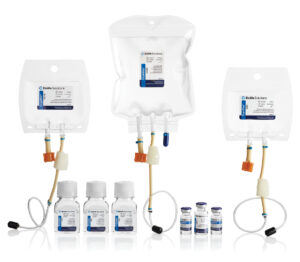Cell-based therapies originate from biological starting materials like blood, bone marrow, or tissue. The cells obtained often require specialized processes and temperature-sensitive protection to remain viable throughout the bioproduction lifecycle.
Cryopreservation, or the process of freezing biological materials at ultra-low or cryogenic temperatures, is one of these processes. At low temperatures cell metabolism which might cause damage to the biological material in question is effectively stopped; and if the cryopreservation process is done effectively, viable cell recovery and function post-thaw will be achieved.
Cryopreservation protocols are often an after-thought for most researchers and manufacturers. As such, these conventional procedures can often result in significant cell damage and/or loss – requiring a larger volume of cells to be prepped to account for the low effective yields after the process has been completed.
Typical Cryopreservation Steps:
- Preparation of your cryopreservation solution
- Addition of the solution to the cellular product
- Freezing the sample
- Storage of the frozen sample
- Thawing of the sample
- Dilution or washing of the sample
- Yield or viability assessment of the sample
At BioLife Solutions, biopreservation is our top focus and expertise. BioLife’s wealth of experience and enabling technology has helped research and clinical organizations significantly improve post-thaw cell/tissue viable recovery and function. Throughout our studies, we have learned that Method Development with consideration to Biopreservation Best Practices often benefits the cell-based product. What you put in is more than likely not what you get out unless you take the time to consider the steps. Here are a few considerations to maximize the viable cell recovery of your cryopreserved product.
Optimizing Biopreservation Yield
- Cryopreservation vehicle solution: replace culture media with an intracellular-like solution such as the CryoStor® family of products, which is an optimized solution containing osmotic/oncotic agents, free radical scavengers, and energy sources to minimize apoptosis, and maximize the post-thaw viable recovery of the functional cells.
- Cell-specific DMSO concentration: 10% is not always optimal. BioLife Solutions offers varying DMSO concentrations with CryoStor CS10, CryoStor CS5, and CryoStor CS2. BioLife Solutions also offers CryoStor CSB, without DMSO, that can be used in combination with other DMSO-containing CryoStor solutions for some advanced manufacturing methods.
- Pre-freeze sample holding time: This step may be optimized to prepare the cells prior to freezing.
- Controlled-rate freezing: apply a “seeding” or ice-nucleation step at a controlled rate to reduce supercooling and intra-cellular ice formation which improves sample consistency.
- Post-thaw sample holding time: the time and handling after the point of ice dissipation may impact the cells.
- Post-thaw analysis of sample: immediate post-thaw analysis often results in incomplete or incorrect characterization of the cells; multiple timepoints and multiple assays through 24-72 hours post-thaw are more likely to provide robust characterization.
 Additional advantages of CryoStor include:
Additional advantages of CryoStor include:
- CryoStor is cGMP-manufactured from raw materials of USP/Multicompendial grade, has a multi-year stability profile, and is backed by BioLife’s Quality Management System to deliver a consistent, quality, high performance product.
- CryoStor is a true off-the-shelf family of solutions pre-formulated with 2%, 5% or 10% DMSO so the end user can adapt their cells to the DMSO concentration that results in optimal cell survival and function for a given cell type.
- CryoStor is serum-free and protein-free.
- CryoStor is a designed, innovative solution that is packaged in multiple volumes and in containers of multiple formats designed to provide options for your process requires in a form factor amenable to scale up. As important as the solution is, the utility is not only about the formulation.
BioLife Solutions advances a Best Practices approach to cryopreservation. BioLife scientists can assist with Biopreservation Best Practices and process optimization. CryoStor is a raw material that has been qualified for use in a variety of customer applications. BioLife scientists are also experts in the regulatory requirements surrounding the use of CryoStor and can assist with appropriate supporting information for regulatory submissions.
For more information or if you have a question for the BioLife Solutions scientific team, please submit your questions at http://www.biolifesolutions.com/ask-the-scientists.
References
- Clarke, D. M. (2009). Optimizing biopreservation yield. Biopreservation Today. Retrieved 2023, from https://www.biolifesolutions.com/wp-content/uploads/2022/11/BPT-Winter_2009.pdf.
- Hawkins, B. J., & Abazari, A. (2015). Cellular immunotherapies: critical biopreservation considerations . Biopreservation Today . Retrieved 2023, from https://www.biolifesolutions.com/wp-content/uploads/2022/11/BPT-Winter_2015.pdf.
- Weaver, M. (2018). BioLife technology vs. homebrew cryopreservation media. Biopreservation Today. Retrieved 2023, from https://www.biolifesolutions.com/wp-content/uploads/2022/11/BPT-Spring-2018-WEB.pdf.